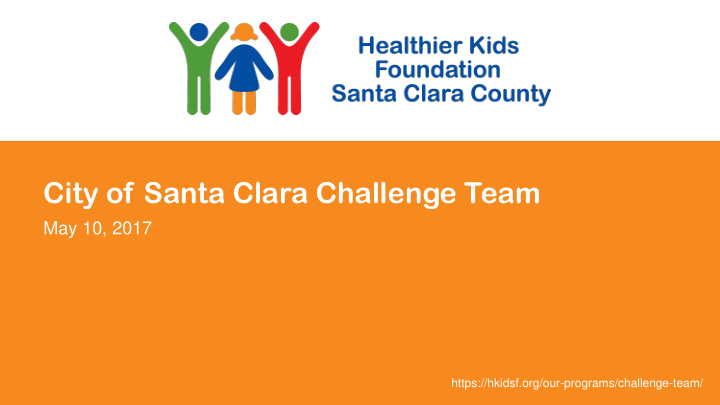



City of Santa Clara Challenge Team May 10, 2017 https://hkidsf.org/our-programs/challenge-team/
Jeremy Loader Martha Gabaray Jeremy@hkidsf.org MarthaG@hkidsf.org Visit the Challenge Team website! www.hkidsf.org/our-programs/challenge-team 2 www.hkidsf.org
Nutrition in Schools Beyond the Classroom Presented by: Jennifer Gacutan-Galang, MPH Nutrition Education and Obesity Prevention Program Supervisor Santa Clara County Public Health Department
Nutrition Education and Obesity Prevention Program • Grant funded by the USDA through the California Department of Public Health • Serve those that are SNAP-Ed eligible • Other funded partners UC CalFresh and Catholic Charities
Nutrition in Schools What does nutrition education look like?
7
Cafeteria Promotion Results HOTM Loved It Liked It Not Today Tomatoes and Cucumber 215 (69%) 51 (16%) 49 (15%) Apples with Yogurt 311 (92%) 9 (3%) 19 (5%) Cara Cara Oranges 370 (94%) 11 (3%) 11 (3%) Kiwi 214 (76%) 25 (9%) 42 (15%) Asparagus 202 (59%) 44 (13%) 98 (28%) Green Smoothie (Spinach & 137 (54%) 70 (28%) 46 (18%) Banana)
What is the Smarter Lunchroom Movement? Where did it come from?
Mindless Eating: Why We Eat More Than We Think • Most food decisions are automatic, or “mindless” • Choice Architecture • “nudging”
4 Basic Principles to Consider The following principles are based on research concerning various environmental cues that influence eating behavior. They are true in school lunchrooms as well as in restaurants, food courts, and even in your home kitchen! Utilize Enhance Improve Increase Suggestive Taste Visibility Convenience Selling Expectations
Eye Appeal • Colorful bowls make food more appealing to students. • Slicing fruits and vegetables increases eye-appeal.
Creative Names
Be a Healthy Eating Hero, too! • Be friendly and point out healthy lunch selections with a smile on your face. • Encourage students to give your favorite foods a try!
In Classroom Education 89 Classes/Month ~3000 Students/Month
Parent Nutrition Education • Classes in English and Spanish • Harvest of the Month Newsletters • School Newsletters • Store Tours/Food Demo
School Events
Part of the Campus Community
District Level Collaboration • District Wellness Committee • District Food & Nutrition Services • School Wellness Policy
What Schools have Public Health NEOP? • Morgan Hill Unified: Barrett, PA Walsh, San Martin/Gwinn • Gilroy Unified: ADB, El Roble, Eliot, Glen View, Rucker • San Jose Unified: Olinder, Washington • Sunnyvale Unified: Lakewood • Mt. View Whisman: Theuerkauf, Castro, Monta Loma • Luther Burbank • Campbell Union: Sherman Oaks
Jennifer Gacutan-Galang, MPH Jennifer.Gacutan@phd.sccgov.org
Santa Clara Unified Nutrition Services Presented by Karen Luna Director, Nutrition Services
National School Lunch Program History Serving a standard lunch to school children started, in both Europe and the United States, with private organizations who were interested in child welfare. In 1946, the school lunch program was made official when the 79th congress recognized its importance. President Harry S. Truman signed the National School Lunch Act, authored by Senator Richard B. Russell Jr.: “It is hereby declared to be the policy of Congress, as a measure of national security, to safeguard the health and well- being of the Nation’s children and to encourage the domestic consumption of nutritious agricultural commodities and other food, by assisting the States, through grants in aid and other means, in providing an adequate supply of food and other facilities for the establishment, maintenance, operation and expansion of nonprofit school lunch programs.” - Sec. 2 The National School Lunch Act, 1946
Healthy Hunger Free Kids Act 2014-15 Healthy, Hunger-Free Kids Act Requirements All breakfast meals must include ½ cup of Fruit or Vegetable All Lunches must include ½ cup of Fruit or Vegetable Sodium reduction requirements – Final target 2023/24 will be 640mg New Calorie requirements by age group
What we do Secondary Schools cook approximately 50% or more of their items from scratch Organic & local produce as much as possible, about 40% is local Salad Bars at all schools Whole grains in all breads Hormone Free chicken and milk
Local Maximize local & seasonal produce Feature a “Fresh Pick” taste test for students
National School Breakfast and Lunch Program o Milk ½ cup of o Meat/ o Fruit Meat Alternate o Veg o Grain Choose 3 for your meal!
Special events BBQ lunches Holiday theme Culinary meals Class collaboratio n
Taste Testing Student taste test with unique and local fruits Included Kumquats, Kiwi, Gooseberries and Tamarind Sampled new menu items
Qualifications for Seamless Summer Participation o Sites within the geographical boundaries of a school attendance area with at least 50 percent of its children approved for free or reduced-price meals are area eligible o Sponsors must participate in the National School Lunch Program
Summer Feeding Seamless Summer Feeding Everyone 18 and under receive free meals Open to the public Last year was the first year for SCUSD We served over 9,000 Breakfast and 21,000 lunches! We are expanding the program this summer! At least 5 locations Santa Clara High School Wilcox High School Don Callejon School Boys & Girls Club @ George Mayne Elementary Two more potential sites in the works! All sites are serving Breakfast and Lunch
Resources FOOD CONNECTION AT SECOND HARVEST FOOD BANK: (800) 984-3663 https://www.fns.usda.gov/summerfoodrocks
Thank you!
Recommend
More recommend